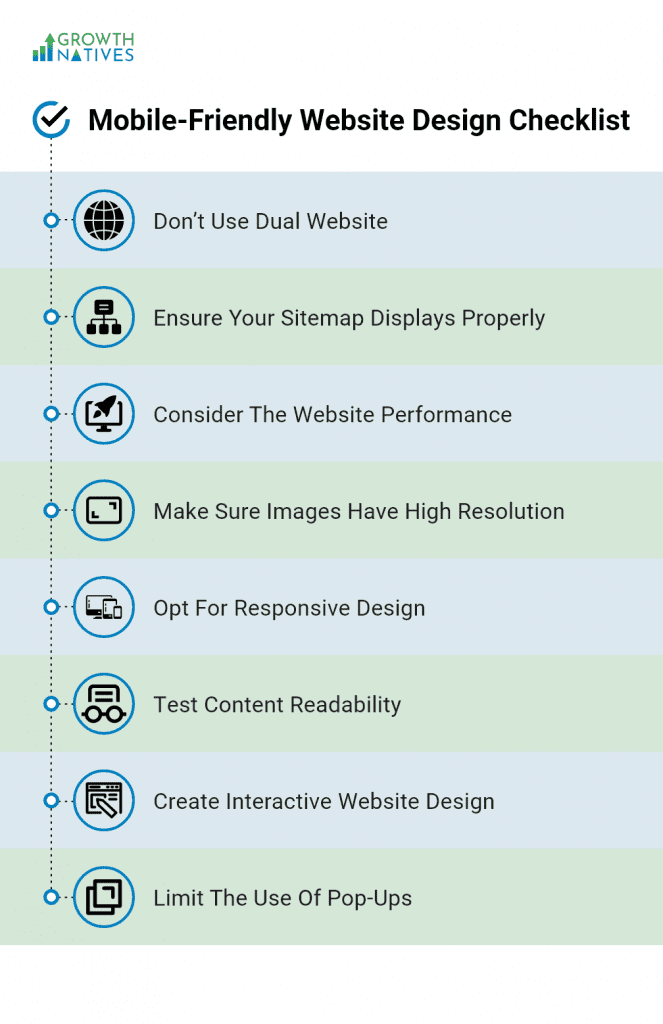
8-Point Checklist for Mobile-Friendly Website Design
By Sakshi Arora
Mar 7, 20229 min read
If your plans don't include mobile, your plans are not finished." - Wendy Clark
Did you know, 47.28% of web traffic in the United States was generated from mobile devices in the fourth quarter of 2021. Also, 57% of users do not recommend a business that has a badly designed mobile website.
Today, 70% of the web has already moved to mobile-first indexing. This means Google indexes the mobile version of your website before the desktop version. So, in terms of SEO, if your website is not mobile-friendly, the chances of it appearing on the first page of SERP are slim.
Today, over half of web searches come from mobile phones, which makes it crucial for companies to have a mobile-friendly website in 2022. The share of mobile devices is increasing year after year, the trend will strengthen in the coming time.
A huge number of visitors are using mobile devices to visit a website. So, if the website is not mobile-friendly, the visitors will jump back to the search results, which can impact your rankings. In simple words, Google prefers fully mobile-optimized websites. Thus, it is important to have a mobile-friendly website that both Google crawlers and your website visitors will love.

The question is, how to create a mobile-friendly website?
Considering the advancements in web designing and increased expectations of consumers, especially during the pandemic, there are a lot of aspects to take into consideration when designing a mobile-friendly website.
Sometimes, people get confused between “mobile-friendly” and “mobile-responsive”. Simply put, a website is “mobile-friendly” if you can effortlessly view its information and interact with it using any kind of mobile devices. However, it is considered “mobile-responsive” when its content changes according to users’ screen size and they get a consistent browsing experience despite the device they are using.
Mobile surfing is rapidly increasing, which means that people rely more on their phones as the primary source of online navigation. If they face any complexities using your site, they jump right to your competitors, which increases your bounce rate and can affect your search engine rankings. Thus, you need to create a website that is accessible on different devices and delivers the same experience.
In this article, we will go over your 8-point mobile friendly checklist to ensure your website provides a satisfactory experience to all the visitors - regardless of the device they use.
Mobile-Friendly Website Design Checklist
1. Don’t Use Dual Website
It was formerly common for firms to create a second mobile-friendly website for consumers in addition to their current desktop website. It is now frowned upon by Google. If you still have two distinct websites for mobile and desktop, it's time to make a change and create one responsive website. You will receive better search engine results as a consequence of this, and you would not need to worry about the content of two distinct websites.
2. Ensure Your Sitemap Displays Properly
Menus are the most common way for visitors to browse your site. Usability will suffer if your links are difficult to click or read at reduced resolutions. Additionally, regardless of the device used to browse, you will want to make sure that all of your menu items are clearly accessible.
Let's go through a few procedures to guarantee you don't miss anything when it's time to test your mobile menus:
- Make sure that all of the menu items are displayed properly on mobile.
- Make sure all of the links are in the right place and that the sub-menus are nested.
- Check that you can both read and click the sitemap.
3. Consider the Website Performance
Your website performance can make or break your online presence, both for SEO and visitors. Below are some statistics that show why mobile website performance matters the most:
- In the past few years, mobile website purchases have reached 35%.
- Mobile applications result in exponential conversions.
- 53% of users abandon pages if the website takes longer than 3 seconds to load.
You will experience negative SEO implications if your website takes too long to load on a mobile device. Furthermore, it also impacts the user experience. You can limit the use of images and content on each page, and also use a caching plugin to speed up the loading process.
Other techniques to make your mobile site run at its best, include:
- Keep the redirects to a minimum or avoid them entirely.
- Optimize the CSS.
- Boost both mobile and desktop performance by improving your service response time.
- Test and optimize your website loading performance. You can try Google PageSpeed Insights for quick results.
4. Make Sure to Use High Resolution Images
Images are an important part of any website, but at lesser resolutions, your graphics might not perform well and can repel visitors. If your logo isn't readable on a mobile device, or the homepage banner is blurred, it will certainly have a negative impact on your branding. The goal is to:
- Set your sights on pictures that are crucial to your brand,
- Look for scaled versions of common picture formats, and
- Choose well-cropped images as they will look better in smaller sizes.
Your website will be good to look at if you cater to these tips for your design. However, in case of graphic content, such as infographics, cropping can result in an unsatisfactory viewer experience.
5. Opt for Responsive Design
Responsive design is not only preferred by Google, but it is also the most popular and easiest to maintain. The term "responsive design" refers to a website that adapts to any device or screen size. Responsive website design has several advantages, such as
- Flexible layouts
- Higher loading speed
- Faster development
- Better Navigation
- Lower bounce rates
- Increased mobile traffic
Responsive design isn't your only choice though. A smartphone app is another possibility. Though it is more expensive than responsive design. Mobile app development also comes with increased development and maintenance costs. Mobile applications function better than responsive websites. You can also provide features that a mobile-friendly website cannot.
6. Test Content Readability
Readability is one of the most important aspects of mobile device use. You need to ensure that you use the right font and font size for mobile websites to make it readable. Remember, if your visitors have to pinch and zoom, you sure are making ways to lose them. You can opt for the following ways to resolve the obstacles:
- Choose a theme that allows you to customize how your text appears.
- For the body of your article, use a clear and readable base font.
- Use heading and subheadings to engage your reader.
Make sure to make content with interactive headings and bullet points as it has more visibility and intrigues viewers to read more as compared to other formats.
7. Create Interactive Website Design
By far we have already covered the importance of sitemap, responsive design, using high resolution images, and right content size. Now, we are going to understand how interactive website design can benefit our mission to create a mobile-friendly website design.
User experience matters! Thus, while creating a mobile-friendly website, it is important to comprehend how your mobile visitors will feel if your website is not interactive. The goal is to design a website that positively responds to users input in the form of some animations or transitions. You need to create a memorable experience for users rather than making them traverse through the page or click on links.
Furthermore, check how your website looks on mobile devices, both Android and iOS. After all, your website elements should be simple to use and navigate with your thumb rather than a mouse.
- Make sure your CTAs, forms, and menu items are all easy to click and simple to navigate.
- Check for any overlap between essential items that might lead to people clicking the incorrect one.
Once you find out the issues and elements that are causing issues, all you need to do is resize them as required.
8. Limit the Use of Pop-Ups
Pop-ups and similar techniques frequently result in considerable conversion gains. They irritate as many people as they convert, though. Obtrusive mobile pop-ups can scare off your website visitors in a blink of an eye. Moreover, your Search Engine Optimization (SEO) rankings will suffer if you utilize pop-ups that conceal your core content or need people to go through them before viewing it.
The following are the reasons the limit pop-ups:
- They're a pain in the neck.
- They prevent stuff from being viewed.
- They force users to go somewhere else, resulting in an increased bounce rate.
How to Know If Your Website Is Mobile-Friendly?
The only way to ensure your website is mobile-friendly is by testing it. It entails testing at all stages of development, as well as maintenance and updates. If at all feasible, test your site on as many different devices as possible. Then, using every browser accessible, evaluate the operation of your website on each device.
You may want to double-check if:
- The pages load swiftly.
- The navigation is user-friendly.
- Both the graphics and text are excellent.
Try Google's Mobile-Friendly Test to check the results. Simply input the URL of your website. When Google will evaluate your site, it will show how your website appears in the search engine when viewed from a mobile device.
Final Thoughts
It is now more crucial than ever to ensure that your website is mobile-friendly. If the current trend continues, mobile traffic will account for the majority of your traffic in the next few years. The best thing you can do right now is deliver a consistent experience across desktop and mobile platforms.
If you are in need of interactive and responsive mobile website design, our experts at Growth Natives can assist. Connect with us at info@growthnatives.com or visit our website and we will take it from there!




